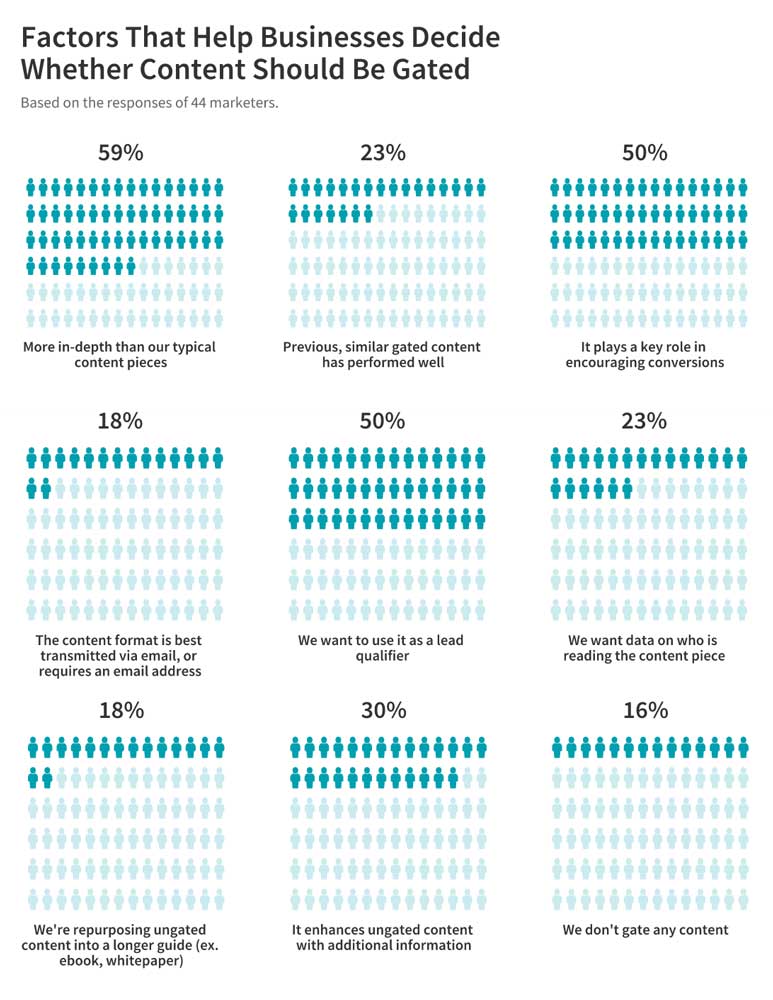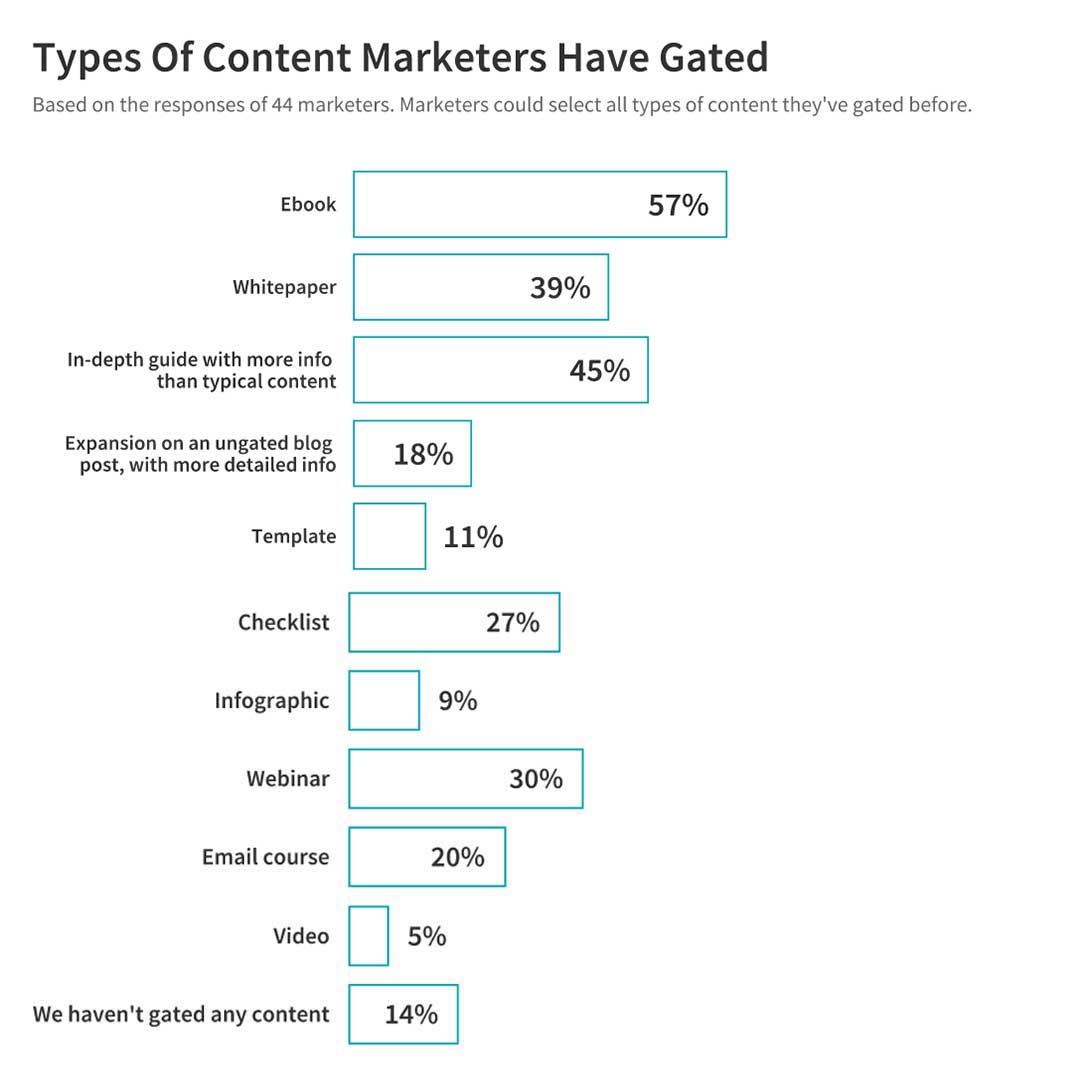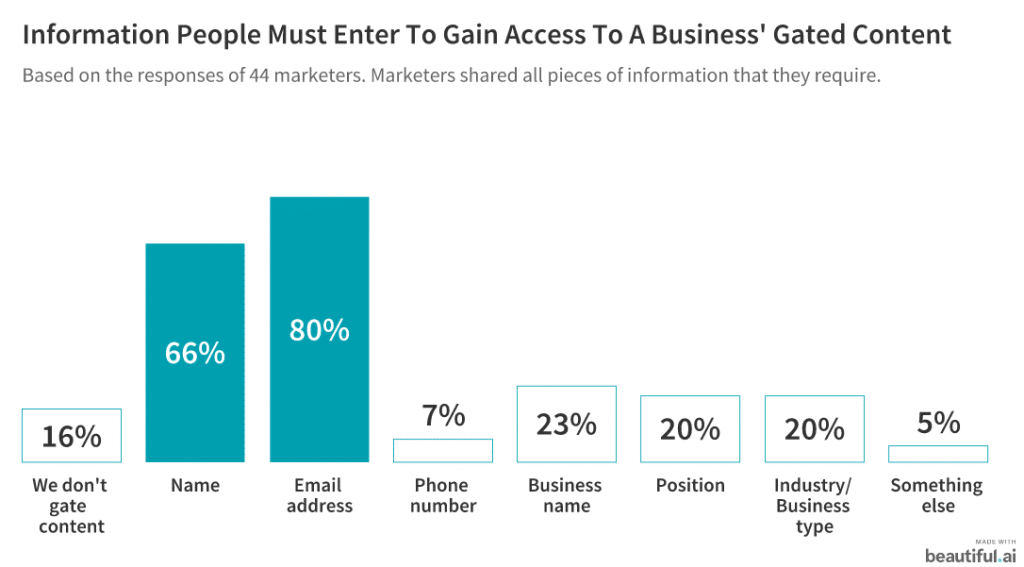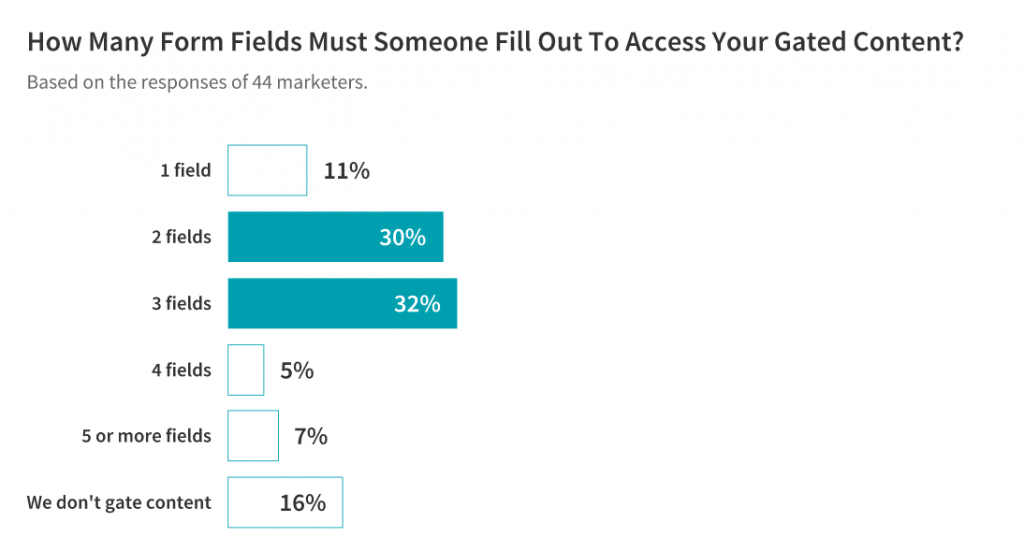It’s one of the biggest debates in content marketing: Should you gate some of your content and require people to enter personal information (like their name, email address, or business name) to access it? Or, should you leave it all open and ungated, free for anyone to access?
We decided to find out where the experts stand on this issue of gated and ungated content. We ran a survey and collected insights from 44 marketers. We’ll share their opinions later in the article. But first, let’s dive into some statistics about how and when marketers choose to gate content.
Gated vs. ungated content: Marketers tend to gate in-depth content
First off, let’s cover exactly what it means to “gate” content. When you “gate” any of your content, you require someone to give information or fill out a short lead form before they can access a piece of content. The information may include their name, email address, business name, position, industry, and/or the like.
Often, the content will be gated behind a landing page that features the lead form, a compelling call-to-action (CTA) advertising the content’s benefits, and a short description of the content piece. Sometimes, a brand will require people to fill out information on a pop-up (for the content to be sent to their email address).
How do marketers decide if a piece of content should be gated? A 59% majority said it should be more in-depth than typical ungated content, making this the most important criteria for gating a piece of content.
Half of marketers said they gate content they want to use as a lead qualifier, and another 50% said they gate content if it plays a key role in encouraging conversions.
We include a full breakdown of results in the graphs below.

Following the trend of gating the most in-depth content, the type of content marketers gate most often is the ebook (57% have gated ebooks before). Similarly, 45% have gated in-depth guides with more information than typical content pieces, making this the second type of most frequently gated content.

How much information should people share to access gated content?
What information should people give in order to access gated content? And how much? About 80% of businesses ask for an email address, and 60% ask for the individual’s name.

The majority of businesses ask for two or three pieces of information before granting access to gated content.
Interestingly, when businesses ask for only one piece of information, it’s always the email address. Businesses that require two pieces of information always require an email address and name.
As for the businesses that asked for three pieces of information, name and email were usually part of their form, but not always.

Gated vs. ungated content: Should you gate?
You’ll need to leave at least some content ungated to build SEO rankings and cultivate trust.
But if you gate content strategically, it can help you generate and qualify valuable leads, while gaining key information to help nurture them.
Still, some potential customers may be tired or wary of gated content. They’re often reluctant giving their email address to be placed on another mass list.
As you can see, gating content comes with both advantages and disadvantages. How much of your content should you gate, if any? How to strike the right balance?
We asked marketers if they think it’s better to gate some content, or leave it all ungated. We received a wide range of responses across the gated vs. ungated content spectrum, sorted below:
Leave all content ungated
“While I understand some of the benefits of gating content, this is not something I currently choose to do. I don’t want to risk losing a customer by gating content simply because my competitor is offering the same but ungated.
“I think brands really need to think about their use of gating and do some research into its effectiveness before doing something which may lose them customers.” –Dima Suponau, Number For Live Person
“I think all content is better left ungated. Gating content can be risky, as it can create a barrier and lead to visitors leaving your site. Most people aren’t willing to leave their information for a piece of content.
“If there is a strong enough motivation, try gating one or two pieces and see how it plays out. I generally advise not to do that, though. There are many different ways to generate leads that are just as efficient.” –Lukasz Zelezny
“Leave as much content ungated as possible. Preferably, all of it. Ungating content today means creating competitive advantage tomorrow.
“First, the trends are pointing toward buyers having less and less patience with marketers who require email to read a piece of content. If you gate today and receive some leads, chances are you’ll see fewer and fewer marketing-qualified leads from your gated content as time passes.
Second, if your content is so valuable to be gated, it’s valuable enough to ungate and let Google index it for a high search engine rank. In the future, you may get more business from search engines indexing your SEO-optimized content than from people registering to read the type of content your competitors give away ungated and for free.” –Visnja Zeljeznjak, Logit
“For the vast majority, it is better to leave all of your content ungated. The reason you’re producing and publishing all the articles, features, and other digital assets is to share them with the site visitors (and hopefully your target audience) to increase your traffic. Provided that you care for the focus and quality, more is indeed better. From our experience, there is simply better ROI.” –Peter Bryla, ResumeLab
Leave most content ungated, but gate a few select pieces
“I believe in making as much content ungated as possible. After all, you want people to take action – why not give them every reason to do so? You don’t want to lose people who would otherwise take action if they had access to better information.
“Our gated content, while free, supports movement toward purchasing and gives people the ability to further take action and see how our tool works.” –Brad Matthews, AdChina.io
“Gating should be used extremely sparingly. My business is all about sharing information in order to snag customers, so it’s not in my best interest to get ‘gatey’ with my users. I’ll only gate webinars and ebooks, and use other methods to obtain user data. In all honesty, gating, along with pop-ups, is one of the things that really annoys internet users.” –Johan Hajji, Upperkey
“Gating content tends to turn away interested readers, as people are highly selective about who they share their contact information with. Hence, this tactic must be used with extreme caution, and only for content that’s truly unique or delivers a lot of value to readers.” –Anu Ramani, Isoline Communications
“The vast majority of content should be ungated. This provides maximum genuine value to the client base and is also best practice for SEO purposes. Have ungated material act as a funnel toward one or two highly valuable pieces of gated content, such as usable templates. This strategy is an easy way to grow an email list. It also helps profile the audience who are particularly interested in your niche.” –Robert Stam, SEO Mandarin
“It used to be a lot easier to get people opting in to receive ebooks, white papers, etc. This is still possible, but people have generally become more aware and protective of their inbox. Instead, I leave the vast majority of content ungated. This helps drive traffic and also showcase the value of overall content. If a visitor gets value from ungated content, they’ll be much more willing to provide their details to access anything gated.” –Michael Glover, ConvertFlow
“Some content should be ungated, with only a select number of pieces being gated. The conversation used to be around gating everything to gain qualified leads. If they filled out a form, they were more likely going to be interested. Back then, there was more perceived value in a free ebook or whitepaper. Now, as there is more content than ever before, customers and potential customers are getting gated content fatigue.” –Ashleigh Kate Baker, HotelFurniture.com
Gate some valuable content
“Gating some of your content is a great way to get more leads through the funnel. It must, however, be worthy of actually being gated. If it fails to appease those who are signing up, the likelihood of them using your goods/services diminishes greatly.” –David Adler, The Travel Secret
“It’s better to gate some content than to gate none. It’s possible to deliver a ton of value with ungated material. But as a marketer, you probably want your visitor to take some kind of direct action on your site. For example, to subscribe to your list. Gated content is the answer, as long as it provides ample value when unlocked.” –Nikola Roza
“I believe your brand should gate at least a bit of its content. You should still give a lot of insightful content for free, but for your in-depth content, such as an ebook, a course, or a white paper, I recommend you ask for an email in exchange. This will help you generate more leads for your business, as well as qualify your visitors.” –Jonathan Aufray, Growth Hackers
“Some of my content is gated, as it’s a great opportunity to further increase my email marketing base. I believe putting content behind too many gates, such as name, phone number, etc. is something that can scare people off. I sacrifice the knowledge about my leads for more of them. So in this case, I think quantity matters more than quality.” –Francois-Louis Mommens, Linkody
“We’re big fans of building brand affinity through long-form content. Therefore, we very rarely gate our core brand content. All of our video series, blogs, podcasts, and playbooks are provided without a gate. We chose to draw the line with demand gen content.
“We use gated content for paid advertising channels, as a way to justify the cost and the value we’re providing. This content, like webinars or robust guides, is typically very targeted to a niche audience and is catered to provide the most value to these specific groups. These highly targeted audiences are also the most valuable for us as a company. We focus on quality, not quantity, when it comes to demand gen, and when to gate our content as part of the sales funnel.” –Meisha Bochicchio, Wistia
Fully embrace gated content
“Gating content has been a valid source of leads, in my experience. Some people are more than willing to leave their details for a valuable piece of knowledge. I gathered large amounts of precious leads. It’s extremely valuable to know who reads your content, and gating some of it can be a great method to learn who your audience is. It also makes them feel your content must be unique and special if it is behind a gate.” –Dmitry Suponau, Number For Live Person
“It’s a good idea to gate some content, as it places more importance on those pieces you really want your viewers to read. Additionally, it’s an excellent way to collect data on people or organizations with an interest in certain topics you present on your site.” –Alexandra Zamolo, Beekeeper
When is it best to gate content?
Many marketers told us it’s important to choose the right types of content, and moments of the buyer’s journey, for the greatest success with gating content. Let’s dive into their advice:
Gate your specialized, unique content (not SEO content)
“It’s best to have some content gated. The question is: Which part of your content should you gate? The content optimized for SEO should stay ungated and work to bring traffic to your website. Most probably, SEO-optimized content will not have anything groundbreakingly new, as your traffic competitors are also trying to write on the same topic.
“When you have something original and unique, it’s quite likely it won’t match popular keywords. This type of truly original content is worth the additional effort and should become gated. You should reward your determined readers, eager to pass through the gate, with something special. Moreover, if you keep it gated, it’s less likely to be copied by your competition.” –Illia Termeno, Fractional CMO
Gate high-quality content (premium content)
“I’m very careful about the content I gate. Why? Quite often, a user will click onto a link hoping for a quick read and will become extremely frustrated when asked to fill in details just to read a measly 500-word blog post.
“My policy is to gate any content that offers lots of quality information, such as an ebook or whitepaper. My advice would be to never gate ‘quick look’ content, such as videos, infographics, and blog posts – the only exception here would be content upgrades for blog posts, which add considerable value to the original.” –Jack Zmudzinski, Future Processing
“Blog posts should generally remain ungated, since gating can cheapen your brand and give users the wrong impression. Instead, you should only gate in-depth how-to guides, whitepapers, helpful templates, and other complex content. These pieces of content seem more valuable and worthy of giving contact information.” –Grant Aldrich, Online Degree
“I tend to gate ebooks, whitepapers, infographics and webinars. These kinds of content are value offerings and, for the most part, people will be happy to hand over info in exchange. On the other hand, I never gate blog posts, videos, and checklists, as these don’t offer enough value. As a rule of thumb, gate any high-value content, such as ebooks, but leave others, like blog posts, ungated. A user who may not initially ‘bite’ with the gated content might read the ungated content, and have their interest level raised enough to crack open that gate.” –Milosz Krasinski, Chilli Fruit Web Consulting
“Gated content should be more valuable – more in-depth, well-researched, well-designed, etc. It should also be more focused on a particular task your customer wants to accomplish. And when someone commits to downloading your ebook, grabbing a white paper, or signing up for a webinar, they’ve presented themselves as qualified leads. This lets you engage them on a much more personal, relevant level. You can offer more value and convince that customer you’re an excellent choice to meet their needs.” –Jeilan Devanesan, Venngage
Gate bottom-of-funnel content
“I believe content at the top and middle of the funnel should not be gated. Only content in the bottom of the funnel should be gated. I don’t give up my contact information for small things. I need value in exchange for my email address. If I am still doing research, I usually prefer to stay anonymous until I narrow down my options.
“Providing ungated content allows the prospect to stay anonymous, which is precisely what they want, otherwise they would have directly contacted you. It also keeps the prospect on your site consuming your content, allowing you to further influence their buyer’s journey.
“However, towards the bottom of the funnel, when your product or service is being considered, you want to get them to gated content so you can follow-up with them directly and gently guide them through the rest of the sales process.” –Joe McMullen, Blackbird Digital Marketing
Use gated content for lead generation
“If you are trying to capture emails to get potential leads into the sales funnel, then gated content is a great tool to have at your disposal. This ties into what’s known as the ‘foot-in-the-door’ technique: asking for a small commitment up front, with the aim of getting the consumer to agree to a larger commitment later.
“By having some ungated content, a user can see the value you have to offer. You can then ask for a small commitment (entering an email) to gain access to the gated content. Once they’ve done that, you can then send them emails via a drip campaign and get them to commit to a larger conversion.” –Tonya Davis, ThoughtLab
Balance gated and ungated content
“Gated and ungated content often play hand in hand. Ungated content brings the visitor to your website and sparks the initial interest in your work. Later, gated content helps convert the visitor into a lead. Once someone makes their way past the form to get your whitepaper or ebook, you can be sure they are interested in your offering.” –Peter Thaleikis, PageExplorer
“The key here is finding the right balance at the right time. We live in a world where people are often suspicious when they get something for free. If they at least have to ‘pay’ with their contact information, they are more likely to associate your product with high quality.
“On the other hand, keeping your content ungated enables greater reach and exposure. Also, there is an opportunity for your content to get positive recognition in social media and go viral. You won’t achieve that if you gate your content.
“I’m a huge fan of providing value first before asking anything from your users. Don’t gate content if you haven’t built expertise and authority in your niche yet. Establish a position in your field first, use ungated content to boost your brand awareness, and only then, start thinking about restricting some of your work.” –EJ Mitchell, LiveCareer
“A strictly ungated content marketing plan can develop an audience, but it leaves the rest of the marketing funnel to chance. How many opportunities never make it past the blog post they started on?
“Conversely, a purely gated content marketing strategy assumes everyone who shows up on the website already knows and trusts you enough to hand over their contact information. Using both helps lay the foundation for a more meaningful relationship.” –Pat Watters, Kolbeco
“Both gated and ungated content are needed, at different stages of the customer journey. Ungated content is required to capture attention and provide value upfront. It moves them closer toward their goal, with nothing asked in return. You can then use gated content to offer more progress towards their goal. We usually create ungated content, promote it with ads to build attention, and then use retargeting ads to offer gated content to the people who viewed the ungated content.” –Skye Khilji, Free The Wage Slave
“You should use both gated and ungated content, but your balance will depend on your goals. Often you need to give away some ungated content to illustrate your expertise, writing style, and knowledge. A visitor is much more likely to submit an email or other contact information in exchange for gated content if they have been able to browse ungated content you’ve produced and like what they see.
“Your goals also affect how much you should gate. If your goal is to increase your email list, you’ll want to include more gated content on your site. If your goal is site traffic/clicks, you might want to offer more ungated content.” –Kayleigh Duggan, ThoughtLab
Wrapping up
As you can see, if you decide to use gated content, you must carefully integrate it with ungated content for the greatest success. Use ungated content to build trust among your audience initially, then gate the more in-depth, high-value content to generate qualified leads who are truly interested.
Still, gating content isn’t always the best move for every business. If you’re still building your SEO profile and working on cultivating your audience’s trust, it may be best to focus on ungated content for now.
The decision between gated vs. ungated content is ultimately up to your business needs and preferences, so choose carefully.



